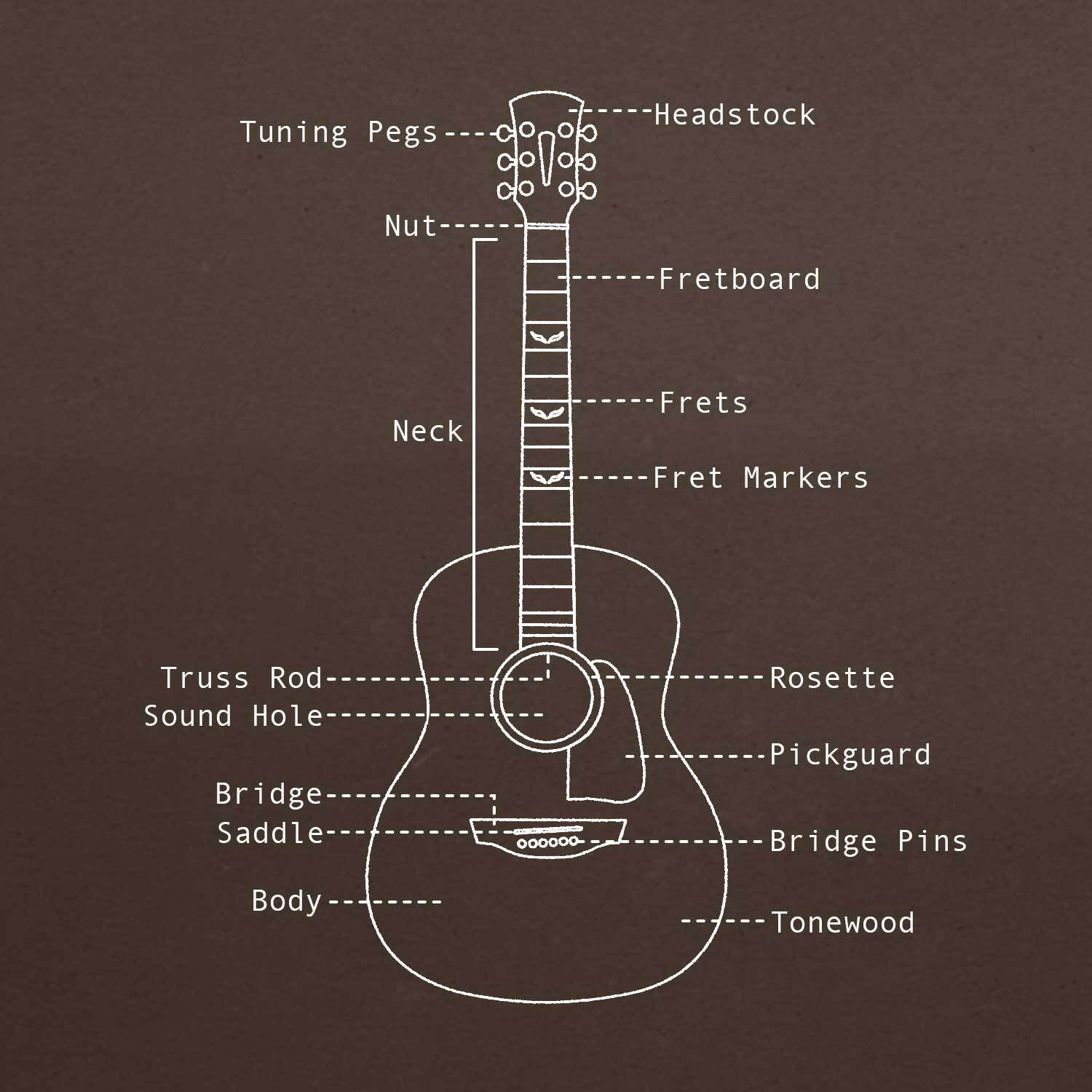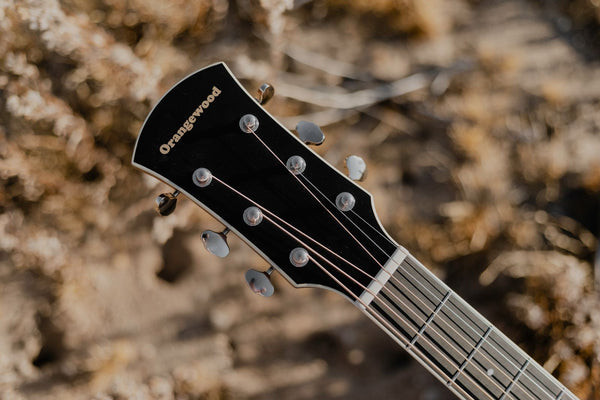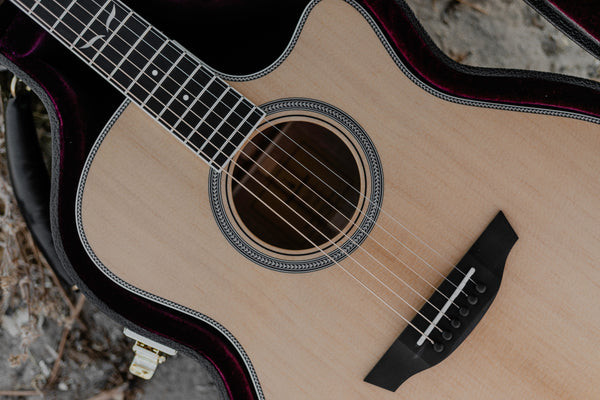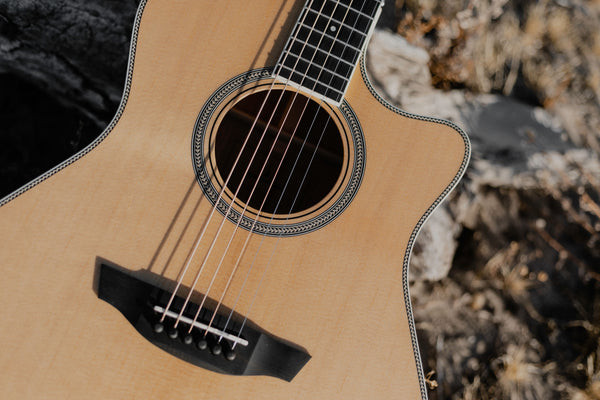Embarking on the journey of learning acoustic guitar is an exciting endeavor! As you begin, one of the most crucial initial steps is to familiarize yourself with the instrument itself. Understanding the different Parts Of An Acoustic Guitar is not just about knowing the names; it’s about grasping how each component contributes to the instrument’s sound and playability.
Without knowing the correct terminology for guitar anatomy, comprehending instructions from your teacher or conversations with fellow guitarists can become challenging. Don’t worry, we’ve got you covered! This guide provides a clear and simple breakdown of the parts of an acoustic guitar, complete with a helpful diagram to visualize each component. Let’s dive into the anatomy of your acoustic guitar.
Exploring the Anatomy of Your Acoustic Guitar
Understanding the components of your acoustic guitar is essential for any beginner. Let’s break down each part in detail:
 Detailed diagram showcasing various parts of an acoustic guitar with labels
Detailed diagram showcasing various parts of an acoustic guitar with labels
The Headstock
Positioned at the very top of the guitar neck, the headstock is also often simply referred to as the ‘head’. This critical section houses the tuning pegs, which are vital for adjusting the pitch of your guitar strings. A robust headstock is essential because it must withstand the constant tension exerted by the strings; a weak headstock can lead to your guitar frequently going out of tune. Interestingly, headstocks are not uniform; their shapes and sizes can vary significantly depending on the guitar manufacturer and model, adding a unique stylistic element to each instrument.
Tuning Pegs (Tuners)
Tuning pegs, or tuners, are located on the headstock and are the mechanisms you rotate to tighten or loosen the guitar strings. This adjustment is how you tune your guitar to the correct pitches. Whenever you undertake the task of changing your guitar strings, you’ll thread each string through the small hole in its respective tuning peg. Then, by winding the peg, you increase the string’s tension until it reaches the desired note, ensuring it’s securely held in tune.
 Close-up image of a guitar headstock showcasing tuning pegs
Close-up image of a guitar headstock showcasing tuning pegs
Nut
The nut is a small but crucial piece, usually made of plastic, bone, or other hard material. It is situated at the juncture of the headstock and the fretboard. The nut plays a key role in string spacing, ensuring each string is correctly positioned apart from the others. It also dictates the string height above the fretboard at the headstock end, known as the ‘action’ at the nut. Furthermore, the nut is important for sound transmission, as it helps transfer the strings’ vibrations to the guitar neck, contributing to the overall resonance of the instrument.
Neck
Extending from the main body of the guitar, the neck is a long piece of wood that is central to the playability of the instrument. It’s a composite structure encompassing several key components: the fretboard (or fingerboard), the frets, the headstock at the end, and internally, the truss rod which is used for adjustments. The neck’s design and construction significantly impact the comfort and ease of playing the guitar.
Fretboard (Fingerboard)
The fretboard, also known as the fingerboard, is a piece of material, typically wood, that is laminated onto the front surface of the neck. This is the surface where your fingers press down on the strings to produce different notes, chords, and melodies. Fretboards are commonly made from different types of wood than the guitar’s neck and body. The choice of wood for the fretboard is not merely aesthetic; it can influence the playing feel, the style of music best suited to the guitar, and even the tonal characteristics of the instrument.
Frets
Frets are the thin metal strips embedded across the fretboard, running perpendicular to the strings. These raised bars are precisely positioned to divide the fretboard into semitone intervals. When you press a string down behind a fret, the fret acts as the end point of the vibrating string length, effectively shortening it and thus raising the pitch. A standard Orangewood guitar typically features 21 frets, providing a wide range of notes across the guitar’s register.
Fret Markers and Inlays
To assist guitarists with navigation on the fretboard, most guitars are equipped with fret markers, also known as inlays. These are visual aids embedded into the fretboard at specific fret positions, typically the 3rd, 5th, 7th, 9th, 12th, and 15th frets. These markers commonly appear as dots, but can also be more decorative shapes or custom designs. Orangewood guitars are easily recognizable by their signature “leaf” inlay, a unique design element that sets them apart. Fret markers are invaluable for quickly and accurately finding positions on the fretboard during playing.
Truss Rod
The truss rod is a crucial internal component, a metal rod embedded within the neck of the guitar. It’s designed to counteract the immense tension exerted by the guitar strings, which would otherwise cause the neck to bow or warp over time. Importantly, the truss rod is adjustable, allowing you to control the amount of curvature, or ‘relief’, in the neck. Adjusting the truss rod is vital for setting up the guitar’s action (string height) and overall playability. If you find your guitar becoming difficult to play or notice it frequently goes out of tune, adjusting the truss rod might be necessary.
Body
The body is the largest section of the acoustic guitar and is a primary determinant of the instrument’s sound. Acoustic guitar bodies come in a variety of shapes, each influencing the tone and projection of the guitar. Popular body shapes include dreadnought, known for its powerful volume; grand concert, favored for its balanced tone; grand auditorium cutaway, offering versatility; parlor guitars, appreciated for their comfort and portability; and mini guitars, which are even smaller and more travel-friendly. The body is constructed from three main parts: the soundboard (top), the back, and the sides. The soundboard is particularly significant as it vibrates to produce sound, making the choice of tonewood for the top, as well as the back and sides, a critical factor in the guitar’s sonic character.
Tonewood
Tonewood specifically refers to the type of wood used for the soundboard, or top, of the guitar’s body. While wood is aesthetically pleasing, different wood species possess unique density and resonance properties, each producing a distinctive tonal quality. Common tonewoods used in Orangewood Guitars include spruce, known for its bright and clear sound; mahogany, valued for its warm and rich tones; and pau ferro, which offers a balanced and articulate sound. The choice of tonewood significantly shapes the guitar’s sonic personality.
Sound Hole
Unique to acoustic instruments, the sound hole is the opening in the guitar’s body, typically positioned beneath the strings. This hole is not merely decorative; it’s essential for allowing the sound generated inside the guitar to project outwards. While sound also emanates from the entire surface of the guitar body, the sound hole acts as a primary exit point, enabling the internal sound vibrations to resonate freely and produce the characteristic acoustic guitar sound.
Rosette
The rosette is the decorative ring or pattern that encircles the sound hole. It’s primarily an aesthetic feature, adding visual appeal to the guitar’s top. However, rosettes can also be a distinguishing feature of different guitar brands or collections. For example, Orangewood Guitars uses various rosette designs to differentiate their guitar lines. The Melrose collection features rosettes with a modern, elegant aesthetic, while the Highland collection incorporates rosettes with a vintage-inspired feel.
Pickguard
The pickguard is a piece of material, often plastic, adhered to the guitar’s top, usually adjacent to the sound hole and below the strings. Its primary function is protective, shielding the relatively soft wood of the guitar’s top from scratches and wear caused by the guitarist’s pick or fingernails during strumming and picking. Pickguards are available in numerous shapes, sizes, and colors, offering a degree of customization to the guitar’s appearance. Orangewood Guitars includes an optional pickguard in the gig bag with all their models, allowing players to decide whether to add this protective and aesthetic element to their instrument.
 Image of a guitar bridge, bridge pins and saddle
Image of a guitar bridge, bridge pins and saddle
Bridge
Located on the guitar’s body, opposite the neck, the bridge is a vital component that serves to anchor the strings to the body. It’s the point where the strings are secured after passing over the soundboard and through the bridge pins. The bridge plays a critical role in transferring the vibrations of the strings to the guitar’s body, particularly the soundboard. This efficient transfer of energy is essential for the guitar to produce a full and resonant sound.
Bridge Pins
Bridge pins are small pegs that are inserted into the bridge to secure the strings in place. They fit into holes in the bridge and press against the ball end of the guitar string, holding it firmly against the bridge and soundboard. Bridge pins are typically made from materials like plastic, wood, or bone, and sometimes metal. When changing strings, you need to remove and reinsert the bridge pins to release and secure the strings.
 Another angle of a guitar bridge showing saddle and bridge pins more clearly
Another angle of a guitar bridge showing saddle and bridge pins more clearly
Saddle
The saddle is a thin strip of material, often bone, plastic, or Tusq, that sits atop the bridge. It’s positioned between the bridge and the strings and serves two main functions. Firstly, it elevates the strings to the correct height above the fretboard at the body end, contributing to the overall string action. Secondly, it’s crucial for transmitting the strings’ vibrations from the bridge directly into the soundboard. The saddle is a key component in the chain of sound production, ensuring efficient energy transfer for optimal tone.
 Full view image of an acoustic guitar highlighting all parts discussed
Full view image of an acoustic guitar highlighting all parts discussed
By understanding these parts of your acoustic guitar, you’re well-equipped to communicate effectively about your instrument and better understand how it works. This knowledge is a fantastic foundation as you continue your guitar playing journey! For further learning and to deepen your guitar knowledge, be sure to explore our Learning Guitar Series, packed with resources to help you progress from beginner to seasoned player.
